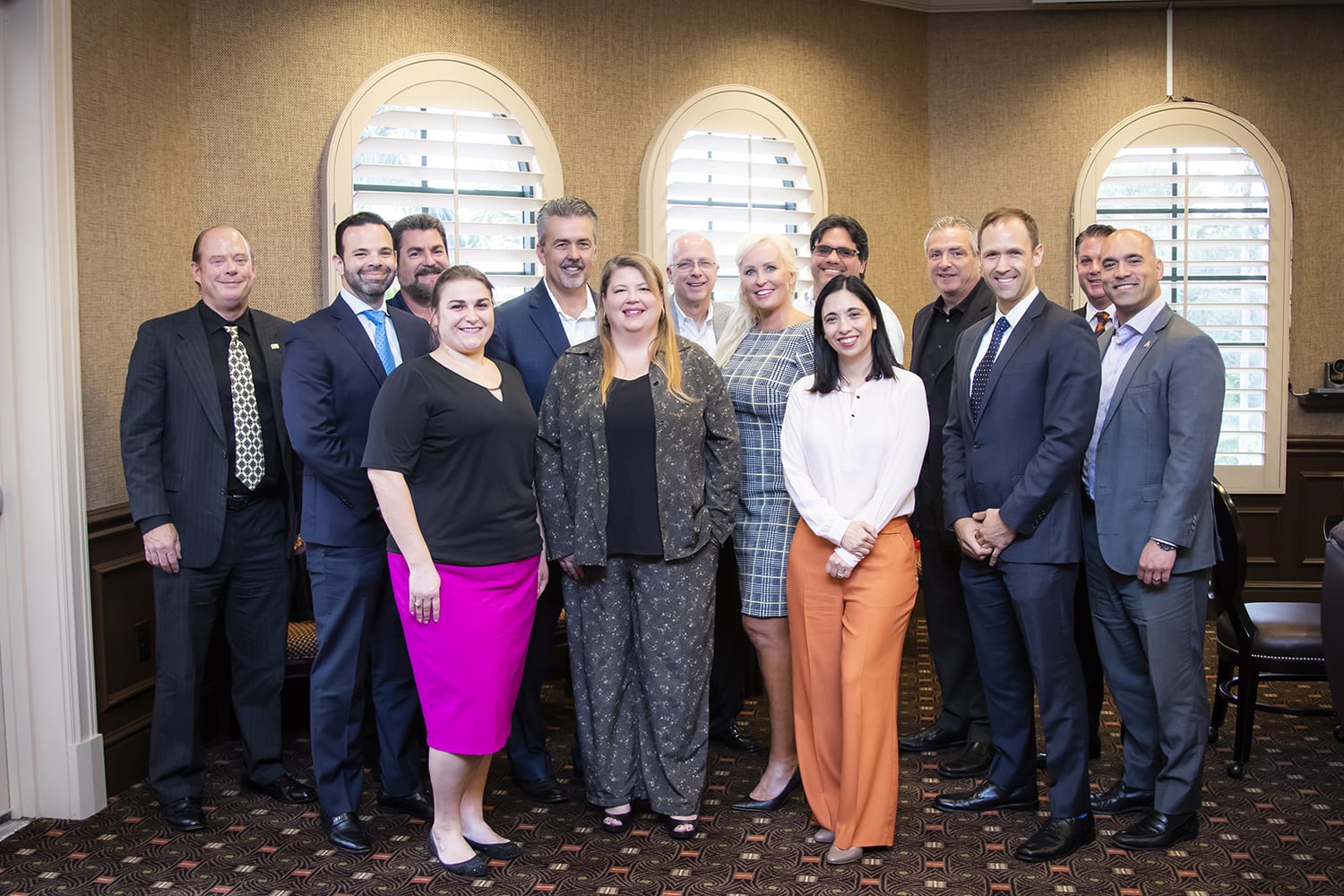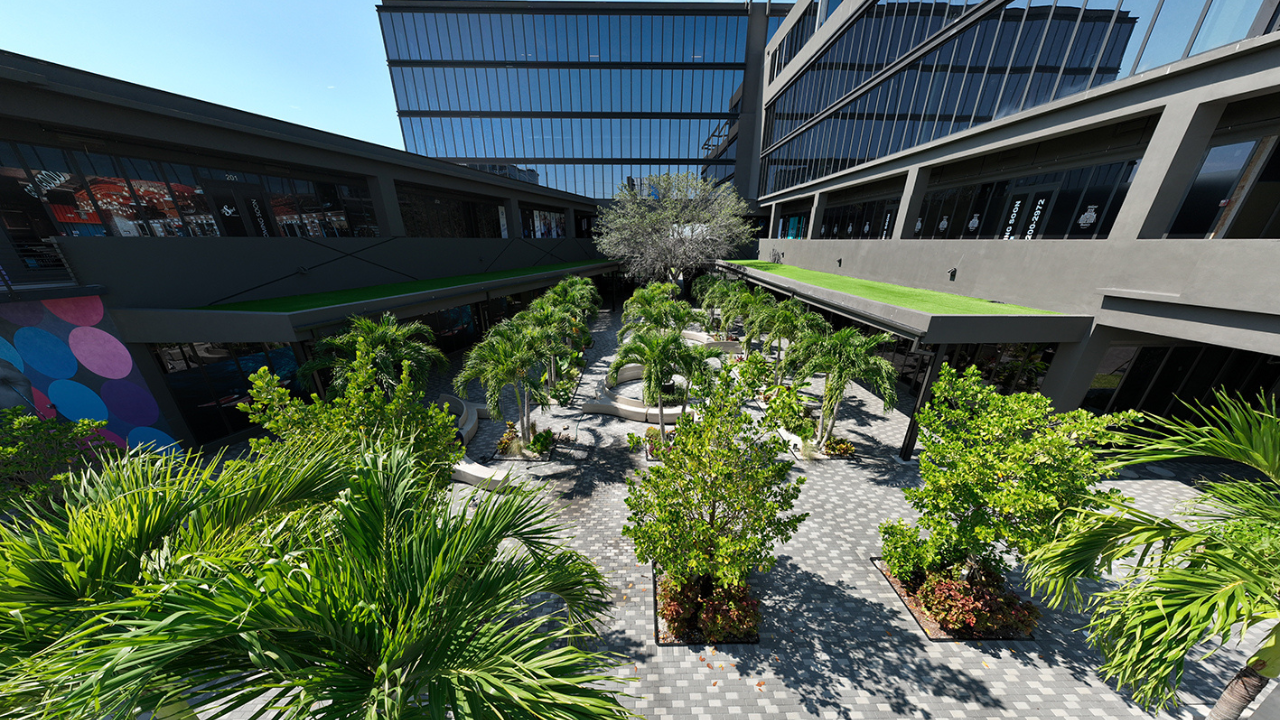[vc_row css_animation=”” row_type=”row” use_row_as_full_screen_section=”no” type=”full_width” angled_section=”no” text_align=”left” background_image_as_pattern=”without_pattern”][vc_column width=”2/3″][vc_column_text]
Sponsored by

Manufacturing is alive and well in South Florida with an estimated 5,000 manufacturers in the region. SFBW partnered with the South Florida Manufacturers Association to take the pulse of the industry, which is being promoted by President Donald Trump, but facing headwinds from trade disputes.
The session was held at the Broken Sound Club in Boca Raton, sponsored by Amerant and moderated by SFBW Editor-in-Chief Kevin Gale. The discussion featured honorees from the SFMA’s annual awards celebration.
The panelists
The panelists were:
The panelists
The panelists were:
• Andrea Cid, managing director of Concept II Cosmetic.
• Andrew Shelton, owner of Paramount Mold and Tool, a plastics injection molding company.
• Mike Heissenberg, owner of Expert Shutter Services.
• Tom Dalton, president of KB Electronics.
• Molly Fiedler, chief innovation officer of Kira Labs, a skin care products manufacturer.
• Alan Garey, president and CEO of Decimal Engineering, which makes metal parts, and a board member of the South Florida Manufacturers Association.
• Ilian Obregon, vice president, middle market banking at Amerant Bank
• Luis Gonzalez-Mendez, executive director of research and development at Trividia Health, which makes diabetes care and other health care products.
• Jay Hess, a FloridaMakes business adviser based with the South Florida Manufacturers Association.
• Matthew R. Rocco, president of the SFMA.
Here are some of the highlights, which have been edited for brevity and clarity.
The SFMA just had its Recognition of Excellence celebration. What would you like to share about the importance of this recognition and takeaways from your participation and hearing about the other honorees?
Heissenberg: Having developed our own company, this experience opened our eyes to a whole world of companies manufacturing different products and processes we didn’t really consider. It has proven vital to the continued growth and development of our company to serve these other companies and get help from the SFMA.
Cid: I think, twofold, it has had a significant impact. First and foremost was the morale booster and sense of pride that came to our employees. Second, the feedback process we received for our employees was specific and detailed on what we do well and what we can improve on.
How many applicants were there and how many made it to the final round?
Hess: There were 83 total, and 16 that made it to the finals.
Cid: We were placed into a finalist group. At that point, Jay and the team had spent several hours going through every major aspect of our business—sales, marketing and a plant tour. It went into a detailed series of questions. There was very specific feedback. There was very good information to come out from an analytical point of view: Here’s what you can target and a path for improvement.
Garey: Jay is leading a team with so much experience. It’s like getting free consulting. Many years ago, we lost in the first round and now we came back eight years later and won manufacturer of the year.
Obregon: It went well beyond what our management review does. It took it to another level of recognizing areas we can improve. Just being nominated made everyone feel better.
Fiedler: More than just measuring corporate success by dollar signs, it gives metrics to compare to other world-class companies. So, starting as a small business in Florida, and essentially in the garage, and moving up, it’s like you look at the dollar signs like, “Hey, we’re getting bigger, we must be getting better,” but not knowing that the better function is in there. It’s actually an honor and a privilege to be able to compare ourselves to other businesses, because as we’ve kind of discovered through this process, business processes are the same.
Dalton: It’s a safe audit because it’s nothing but improvement for your business and continuous improvement, as opposed to being worried that you’re going to get caught with something.
Gonzalez-Mendez: The FDA, OSHA, all these regulatory agencies, they always talk about good manufacturing processes, and a good amount about hiring practices. They always tell you, “You need to be at the leading edge, and you need to see what is being done out there.” But, guess what? Nobody’s telling you what that is. It’s easy to go to guidelines in the FDA, and they’re just that: guidelines, but you never know how far the other companies are. And that can put you in a precarious situation. And now we understand what other people are doing. I can do that better. I can do this better.
South Florida doesn’t tend to have big manufacturing plants like automakers, and manufacturers are often tucked away on side streets. I’m sometimes amazed what I find. How much manufacturing activity is there in South Florida compared with the general public perception?
Hess: I’m like you, I drive down the street, and my head is going in both directions all the time. We are not only opportunistic in some respects, but it’s sort of amazing, particularly from county to county the differences and the commodities that are produced tend to differ as well. [Hess alluded to a study that rank Florida high for entrepreneurship. The Kauffman Foundation ranks South Florida No. 1 on its Index of Startup Activity.]
What’s the basis? I have my own theory. Everybody comes to Broken Sound, golfs a little while, and realizes they can’t golf every day. They think, “Let’s start again.” So, there is a self-generating positioning of entrepreneurial individuals in the South Florida economy. Some of them, like in this year’s competition, had only four or five employees. We also had one that is 1,600.
Fiedler: There’s actually a very low barrier to entry to starting a business in Florida, and there’s actually a lot of encouragement. There are ready resources; both Miami-Dade and Broward counties have people who will help you get started. With the state of Florida’s SunBiz website, you can get up one morning and say, “I’m going to do something new,” and it’s all ready for young people to get help.
Garey: The state has done a much better job of supporting manufacturers and the SFMA. Manufacturing is alive in Florida, which is looked at as a tourism state. People think of manufacturing as smokestacks, but we have beautiful buildings with automated robots and welding.
Shelton: We are a supplier to many of the manufacturing companies around here. There is so much opportunity that it is not hard to find.
Rocco: There are approximately 5,000 manufacturers in the tri-county area. Jay can attest most are less than 50, less than 25 employees. You drive by and look and don’t know what’s happening in that building.
We hear a lot about businesses relocating from high tax states to Florida. What’s your perspective?
Dalton: The genesis of KB being in Florida was just that. Crime was a problem in Brooklyn. They were stealing ACs off the roof. We had union problems, expense problems. We got down here and it was easier.
Garey: We did look at moving recently. There are tax advantages here with no state income tax. The SFMA worked closely with the state and legislature. There’s no sales tax anymore on bringing equipment into the state. (It used to be 6 percent.) This allowed us to invest more in the business. We worked with the Greater Fort Lauderdale Alliance to work on tax incentives to stay in the state.
Gonzalez-Mendez: We’ve seen bigger companies—top 500 companies—looking at Florida. I previously worked with Procter and Gamble. For the first time in the last 10 years, they have brought the state of Florida into conversations about manufacturing, where they basically for many years would never talk about Florida because of its location. Geographically, it didn’t make sense. They’re all about logistics and all that. And now suddenly, Florida is part of it. One reason is globalization. Florida can supply to Latin America in an easier way.
What are some of the economic pros and cons of manufacturing in South Florida, such as cost of real estate, cost of labor, geographic location and quality of the workforce?
Gonzalez-Mendez: Skilled labor is a challenge for every manufacturer in South Florida. Labor needs are changing. There is more technical work and quality assessments. We are in a new era of being data-driven and need people that can see information and translate that into what it means. We have engineers, but need operators to understand how the machine is behaving before it breaks down. We need people with a desire to be in manufacturing. People in high school don’t know manufacturing. Most of them are high-tech, well-paying jobs that no one knows about. Sometimes a high school degree doesn’t cut it. That’s why we are partnering with Broward College.
Cid: It’s not going to get solved overnight. There are skill sets starting from basic schooling. There needs to be training and looking at the pipeline of careers. There’s an unconscious bias, particularly for women. I would love to see more women as contractors, engineers and machinists. We see tons of billboards moving women into nail technicians and the beauty industry. Those pay a third of what manufacturing would pay.
Shelton: I’m not sure taxes are a consideration. The challenges are always related to training and how much we all make. It’s harder in the last two years to hire for entry level. The expectation of what they should know continues to increase. When a Walmart greeter is making $15 an hour, it’s harder to bring someone in at an entry level price and do statistics.
What’s your outlook for business in the rest of 2019?
Dalton: We see double-digit growth. There’s a little bit of headwind from trade with some components from China. We’ve made adjustments and it’s not having an impact on prices as a whole. Since we build units in Florida, it’s a United States product.
Cid: We’ve been quite affected by the tariffs. Half of what we have in our warehouse originates from China, or, if I buy from someone in the U.S., they are getting material from China. It took a while for it to start hitting us. We have had to shift some major suppliers. We have back orders as a result. I hope it gets resolved as soon as possible.
I’ve been able to pass along 5 percent increases, which is decent. What I’ve done is launched new product lines and repositioned certain product lines. Old stuff at the old price. New stuff at the new price. New designs and new fragrances.
Garey: We’re moving to a new building and doubling the size of the footprint. We were one of the first ones to get the shock of metal tariffs a year and a half ago. It was a shock at first and everyone was freaking out, but everyone is in the same boat as we are. We were forced to pass along prices. We have contractors who said, “We never anticipated tariffs,” and now they are written into contracts.
Fiedler: We have invested heavily in the supply chain in the U.S. and have been able to beat some our competitors where they have had orders stuck at ports. We are working with materials that are here and from other countries. At some point, the whole supply chain is at risk. If any of you remember in the 1990s when they took all the equipment and moved it to China, I don’t see it coming back here. I see it going to other places. If you are changing the supply chain from China to India or South America, it’s just changing the risk.
Shelton: We have a long lead time. Somewhat in the range of 25 percent of our annual spending is overseas with vendors. That’s an eight- to 12-month lead time for some of the tools we are building. You don’t just change that mid-stream. We have been able to pass on 90 percent.
Fiedler: There is also a mentoring gap when you move from China to Vietnam or India. There’s not a mature group of leadership to get the same quality. India has great engineering and resources, but they are not hitting the quality standards in China. I would rather see it come back home.
Hess: I don’t want to see the equipment I moved to China in the 1990s. People onshoring today are not using technology they offshored yesterday. The only way we win this game is by taking on this tech curve. The cost in the U.S., if you smashed every industry together, was probably 50/50 material and labor. If you look now, labor is below 21 percent. At some companies, it’s single digit.
Dalton: About 20 years ago, SARS happened and shut us down for two months. We lost 30 percent of business. I realized then that you can’t have all your stuff in one country. You can’t risk that. A lot of us are sobering up. ♦
[/vc_column_text][/vc_column][vc_column width=”1/3″][vc_gallery interval=”3″ images=”32690,32689,32688,32684,32687,32686,32685,32683,32682,32681,32680,32679″][/vc_column][/vc_row]














